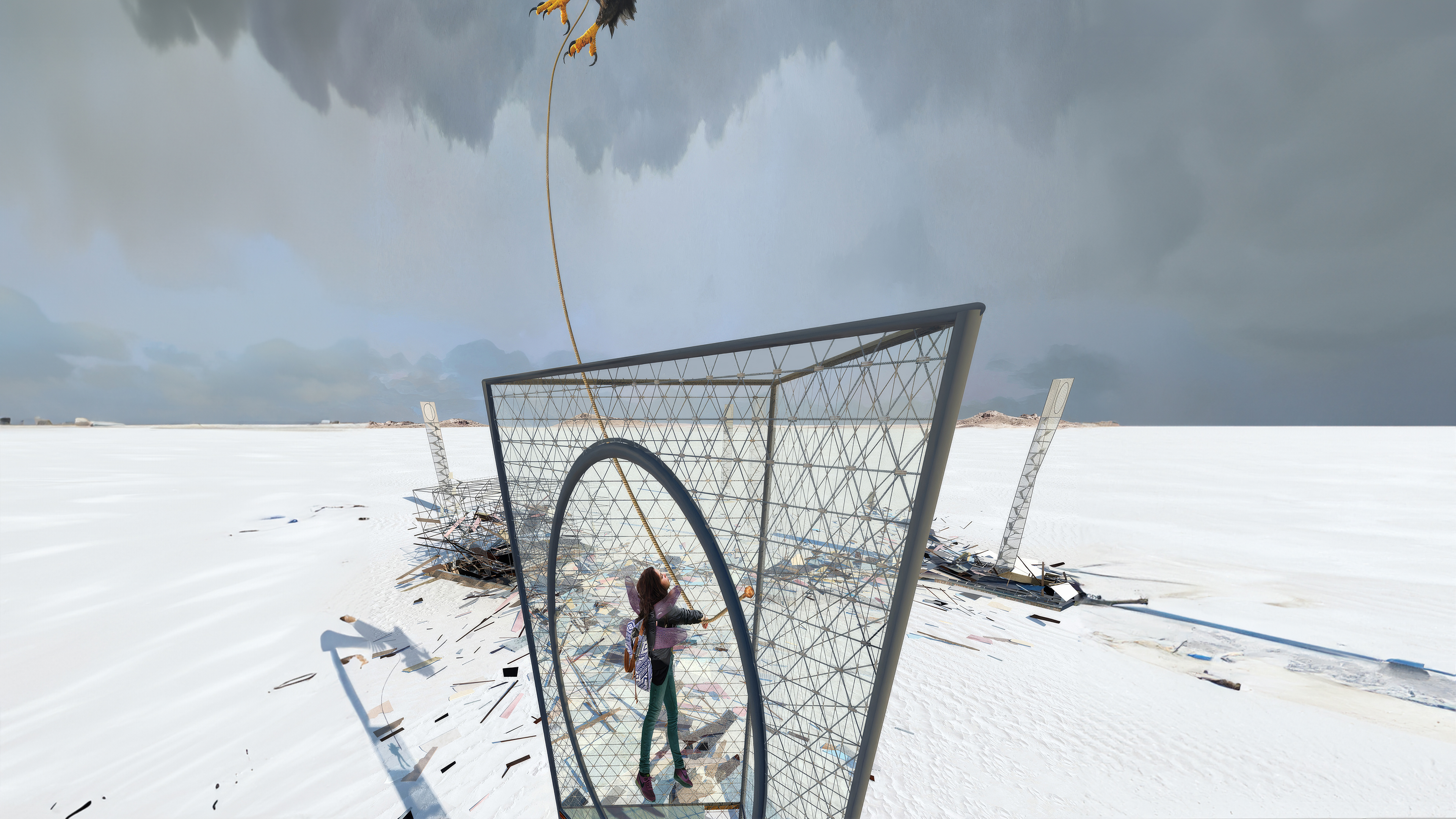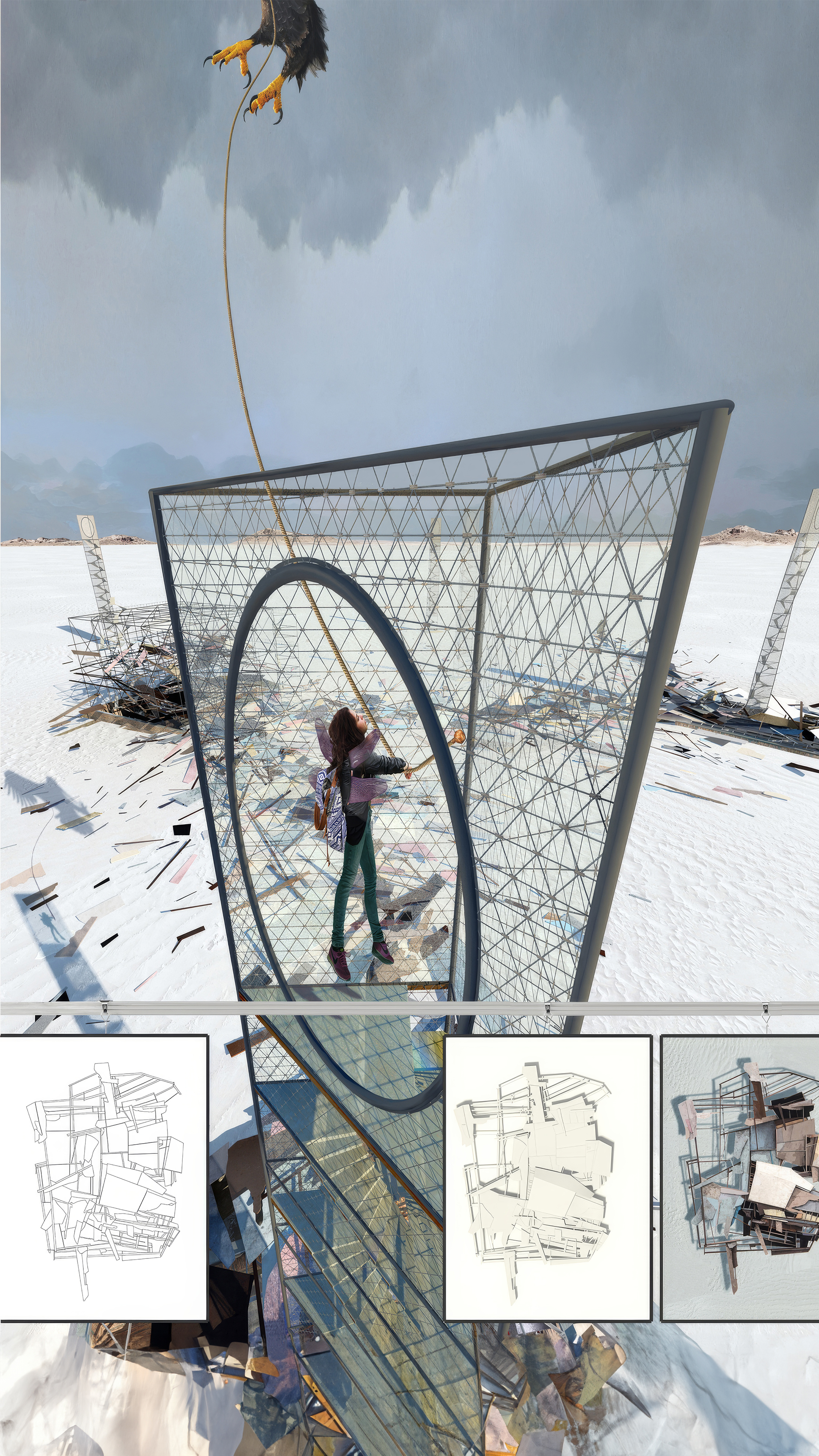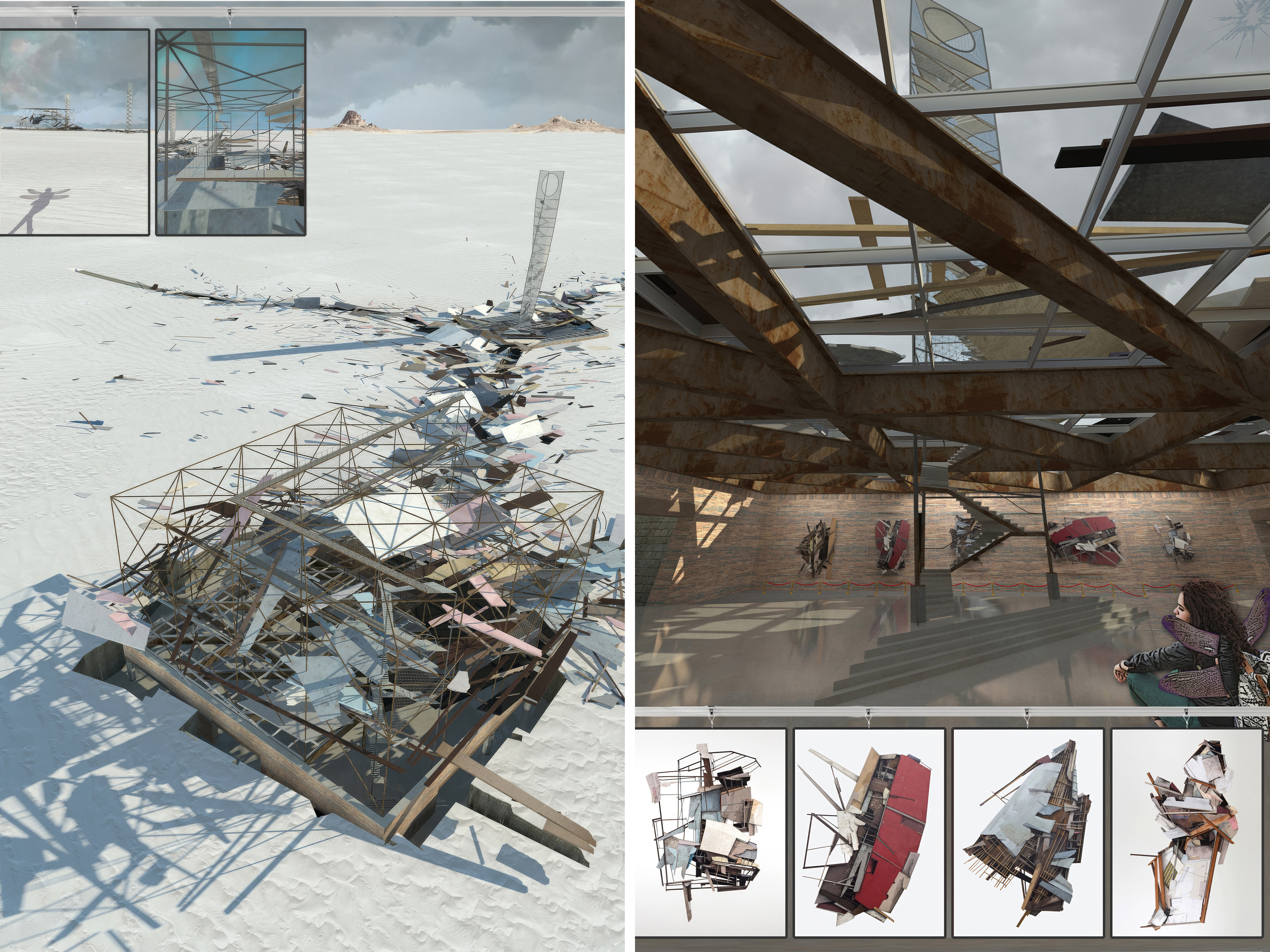A Fairy Tale
This project was submitted to the 2019 Fairy Tales competition by Blank Space in collaboration with the artist, Seth Clark. In this story, Two travelers visit ancient desert ruins to document the excesses of times past. Click here for some process imagery and here for a conversation between the architect and the artist:
The Ruins
As Beatrice and Isidora wander the deserts in search of evidence, they are hardheaded about the pleasures of the past. In olden times the objects they are seeking, removed from their origin and use value, would have become souvenirs on their shelves back home, “authentic” evidence of their boldness, idealized projections of the sweet-dreamy past. No longer.
Slashed by the hot early morning winds, the pair are happy to rest at the top of a scrub-covered plateau next to a faded road sign marked, “Next Service 72 miles”. Demounting from their winged steeds, Isidora quiets the synthetic beasts while Isidora inserts tubes into their precious water tanks and expertly extracts moist pulp with her machete from two red flowered Prickly Pears. Then they unfold their blankets and sit on the ground, careful to avoid grazing their six foot tall figures on the scalded dirt.
Read More >The Past
As Isidora scans the horizon with her binoculars, Beatrice sips and considers the irony that historians now employ the term, “Third World” to refer to their current place in space/time. She remembers her teacher explaining that back in the twentieth century Third World was a derogatory expression referring to parts of the globe that were poor and undeveloped. He called that period when the planet was filled with buzzing automobiles, ever-expanding gridded housing tracts, and coal-belching power plants, the “First World”.
“After the fire, the fire still burns”: Beatrice had learned they were once words from a song. He went on to tell her that the “Second World” came into being after the great collapse when climate change led to the death of millions. There was still wealth then in places. The tatters of technology allowed many to maintain their previous standard of living even as expanding oceans swallowed Italy’s boot, malarial mosquitoes terrorized Belgium, and sweltering temperatures denuded Ukranian farmland. Aficionados still lived the high life, “sipping their Siberian Syrah” as the saying went in those days, creating sentimental museums out of First World ruins to worship the sacred times they pretended to maintain even as northern Africa fried like Jalebi.
Yet all things decay. Beatrice considers the Third World where they now live. It is a time when entropy reigns, one in which constructed objects are slowly returning to their original organic state. This is not like the pretend machine-age tech games she played back in the Nest. The large-muscled, earth-tugging power of nature had prevailed. She feels something graze her leg and, startled, looks around for snakes. Sighing, she calms herself. “It’s dusty here”, she says. The gray land has not only been stripped of its nutrients, it has also been stripped of its romantic qualities.
The Journey
“I see something,” says Isidora, and points to where five tall pillars are just visible rising up from a deep valley near the eastern horizon. They don their masks and instruct the mounts to wait unless signaled, knowing that, man-made or not, the beasts would suffocate if they entered the gassy low-lands.
As Beatrice and Isidora hike closer, they see the Ruins springing forth like fractured shadows from the pillar bases. It is just like Canberra, she thinks: The ancient Ruin pieces appear to be floating, suspended lovingly on a gridded steel network laced with walkways just above where they would have fallen. Surrounding them like soldiers on guard are the pillars.
Now they can see that the pillars are actually towers clad with metal mesh. Inside each are a nearly endless series of steps that lead to view portals situated well above the deadly miasma.
“Clearly Second World,” says Beatrice, and coughs into her mask. Below the decomposing forms, a network of partially submerged glass-roofed trails connects the towers to the dense Ruin center, where the air is so foul they fear to trespass even wearing their masks. “The entrance should be straight ahead. We should be able to breathe again once we are inside.” Sure enough they quickly discover a long ramp that leads them under the wreckage.
Soon they arrive in a sixty-meter-wide square room with continuous glazing overhead that frames the Ruin core above. Amazingly the glass is still intact. Ancient photographs, drawings, and models documenting the Ruin history fill the walls. Shards of sunlight dapple the stone floors. “This is where the services must have taken place,” says Isidora, in a hushed voice. As they pause to document the room, the space is dead silent save for the sound of their scribbling pencils.
The Climb
When their work is complete, Isidora picks one of the two winding corridors that slithers from the shrine in the direction of the towers. Bea takes the other, admiring the Ruin fragments decorating the walls as she walks. An hour later, each arrives at a stairway base and climbs slowly upward through the debris into the open sky. Stopping every ten minutes to rest, Beatrice catch glimpses of her partner in the adjacent tower and marvels at the expanding view.
The pair ascend higher and higher until looking down through the glass at the ruins far below makes their heads wobble and their breath catch tight. The sun is setting red as they arrive simultaneously at the portals.
How can our elders expect so much from us, Beatrice thinks. After all we’re only human, just fifty generations removed from the fire… Exhausted but relieved, she moves to the railing, waves lightly to Isidora, and gazes down at the scattered remains far below. The desert floor appears deeply grooved in the shimmering glare, a palimpsest of lines and fissures. Although the two towers and the field generate deep grayish-purple shadows that stripe the desert floor, the Ruins themselves are imprecisely defined, wavering and watery at long last.
Beatrice realizes looking out that this complex is neither a simple representation of the past nor a utopia. It is too obviously violent. But the passage of Third World time has worked it magic for at least a moment, reinvesting the Ruins with genuine meaning, sowing the seeds of a not-yet-resolved-but-possibly-optimistic future. Then the sun dips over the horizon, the light quickly fades to dusk, and they summon their mounts.
The Return
It isn’t till they are half way home that Beatrice rubs her delicate undeveloped wings against the chitinous exoskeleton plates of her jade abdomen and shouts over the wind to Isidora, “How can I help but love this remarkable, crumbling world. It creaks and limps just like my Grandma!” The pleasurable thought makes her antennae wiggle with pleasure as she refocuses her attention on the starry journey.




